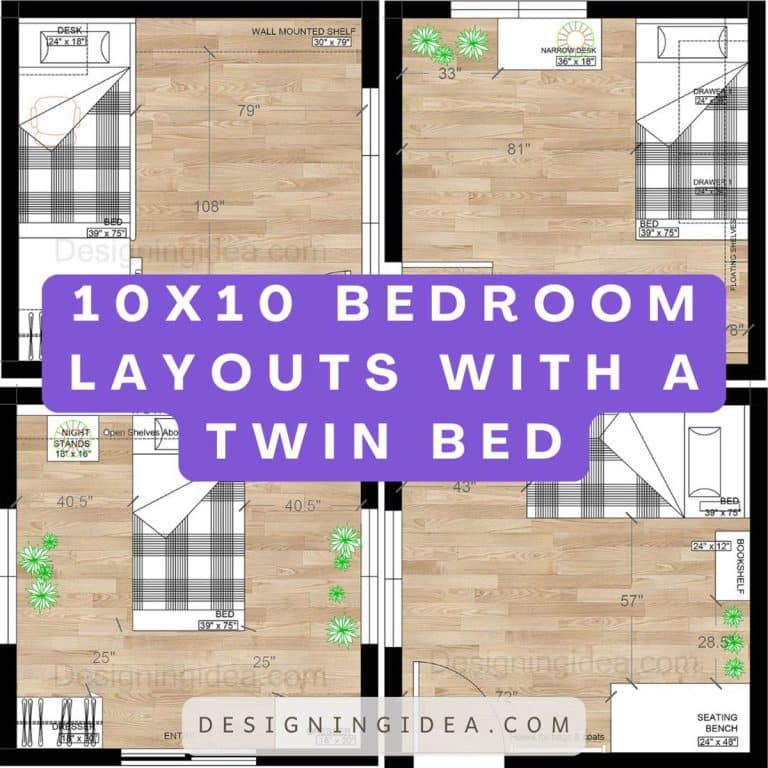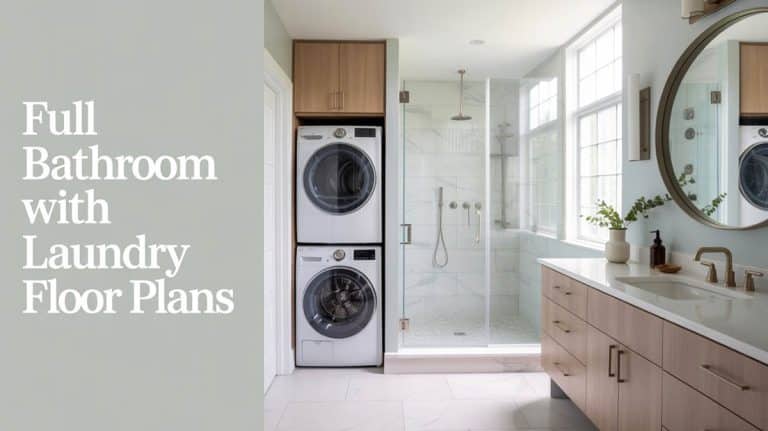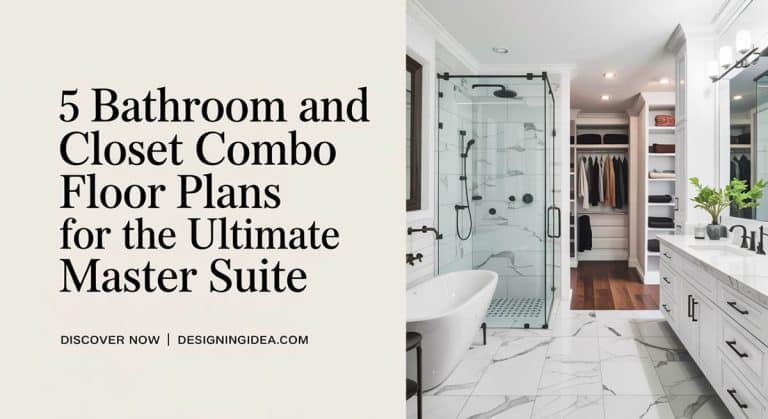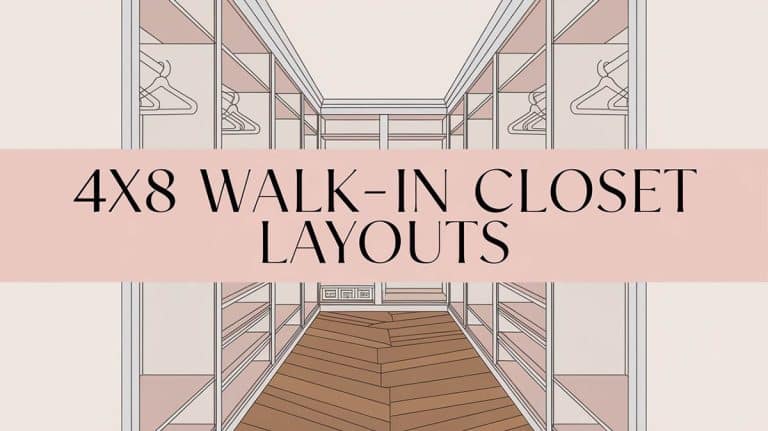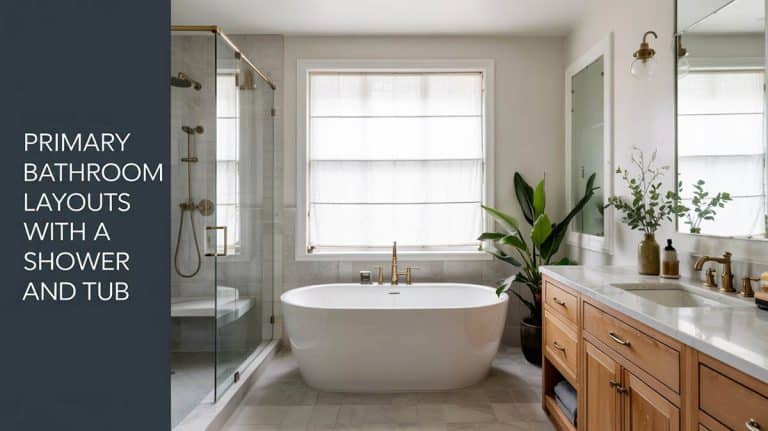10 Space-Saving Bedroom Layouts for Small Children

Growing up in a clean and organized space helps young children value order. With a well-thought-out plan, even small bedrooms can be comfortable and safe while housing all necessary items a child needs in his or her holistic development. Many parents face the challenge of fitting all their child’s belongings into a small space. But with a little creativity and planning, you can transform your child’s room into a functional and stylish haven. In this article, we’ll explore 10 space-saving bedroom layouts specifically designed for small children’s rooms. From clever storage solutions to multifunctional furniture, these ideas will help you maximize every square inch and create a cozy, organized space for your little one.
Bunk Beds with Storage Drawers
Use bunk beds with built-in drawers under the bottom bunk for storing clothes, toys, or bedding. The top bunk optimizes vertical space, leaving room underneath for play or study areas.
Layout: The bunk bed is oriented lengthwise along the longest side of the room, where the stairs and storage are placed on the sides. The study desk and wardrobe are also oriented lengthwise to give way to a central aisle. A climbing wall fits at one of the longest sides, opposite the main entrance point, as it provides accessibility and easier monitoring outside the room.
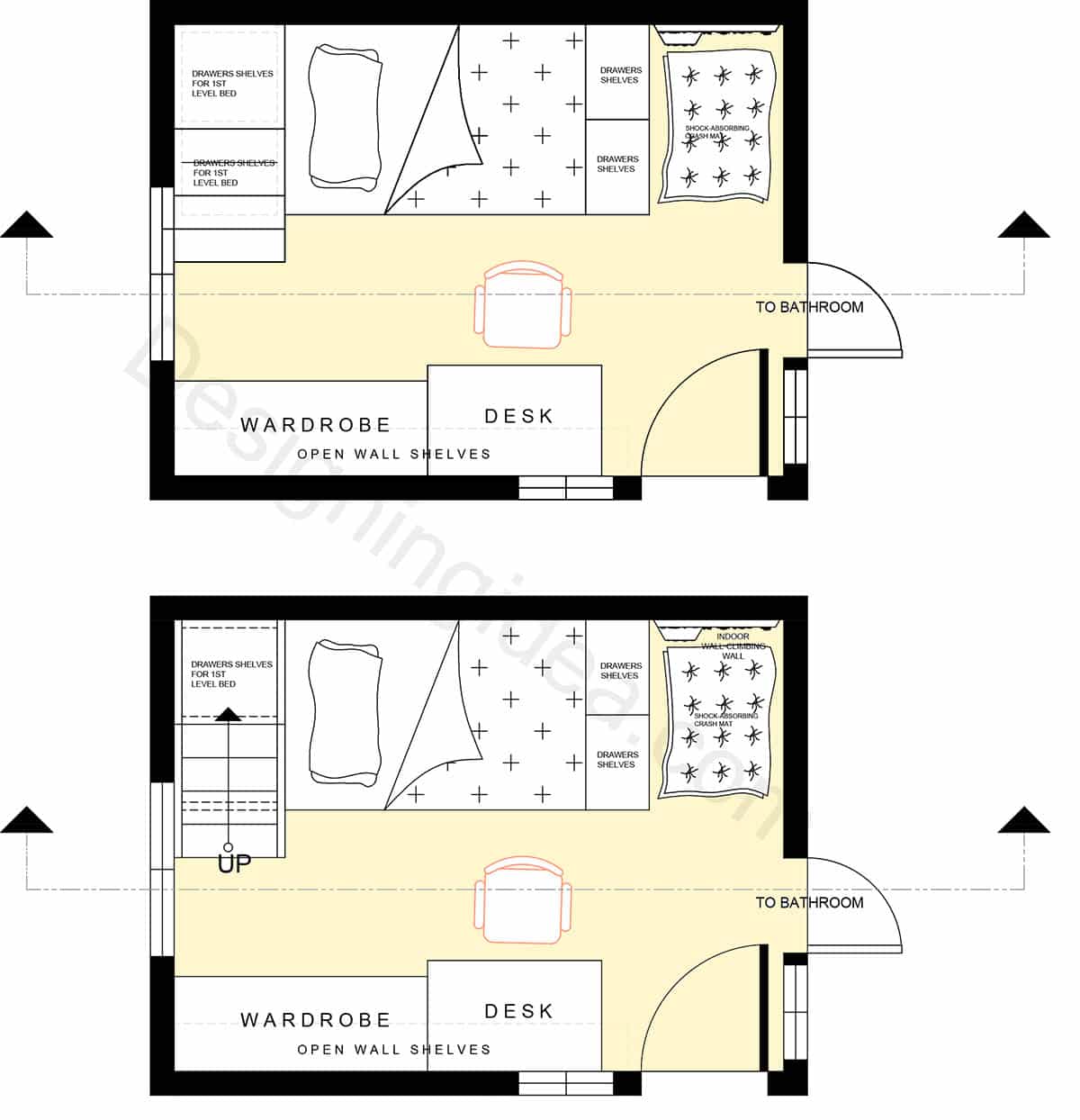
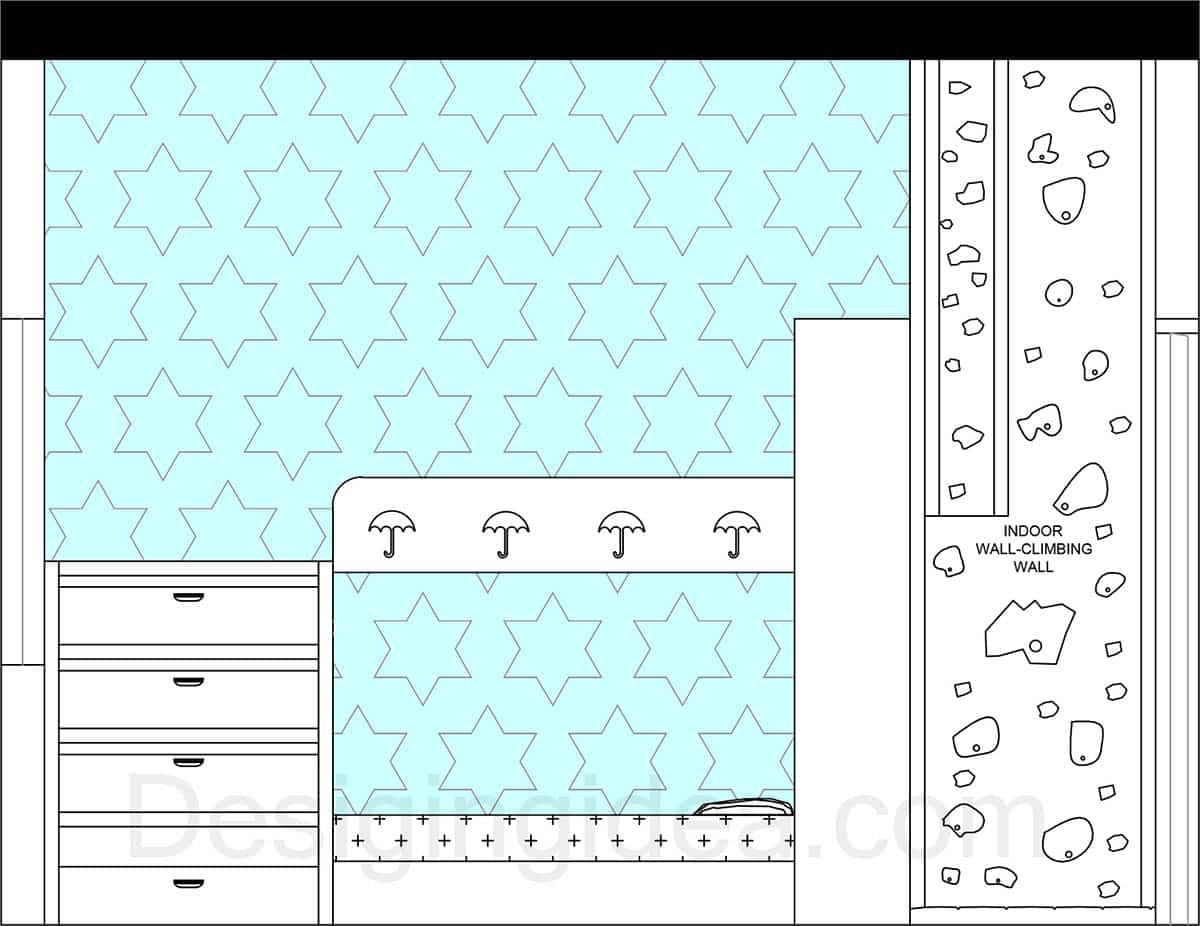
What is a safe age for children to sleep on the top bunker? 6 years and above.
The youngest child has the coordination, dexterity, and judgment to climb a bunk bed. A study, according to the executive director of Safe Kids Canada, Pamela Fuselli, advised that many of the accidents by young children are caused by kids falling from bunk beds and ladders.
Benefits of Bunk Beds with Storage Drawers:
- Space is Optimized: Especially for small kids’ bedrooms, bunk beds free up precious square footage that can translate to a larger play area.
- Vertical Space is Utilized: The most underused space in a room is the vertical area. The bunk beds utilize this space, which also fills up the void in this room, creating a cozier bedroom atmosphere.
- Versatile Space: A bunk bed can be a versatile space to store items for a child or can be tidied up to make way for another bed for sleepovers, either at the top or lower bed level.
Considerations for Choosing Bunk Beds with Storage Drawers:
- Size: Ensure that the bunk bed is the right size for your child’s room and that the drawers are spacious enough to accommodate your storage needs.
- Weight Capacity: Check the weight capacity of the top bunk to ensure it is safe for your child’s weight.
- Material: Consider the material of the bunk bed, such as wood or metal, based on your preferences and durability requirements.
- Style: Choose a bunk bed that complements the overall style of your child’s room.
By incorporating built-in storage drawers, bunk beds can offer a practical and stylish solution for maximizing space and keeping bedrooms organized.
Loft Bed with Play Area Below
Install a loft bed to free up space underneath for a small play area, desk, or reading nook. You can even add curtains to create a cozy fort-like space for playtime.
Layout: Since loft beds can create and free up space, it is a great way to integrate sleeping, studying, and playing areas in a kid’s bedroom. In this layout, the bed is tucked in a corner with a loft frame. Placing the bed on the top level frees up space for the main level while creating a cozy play area.
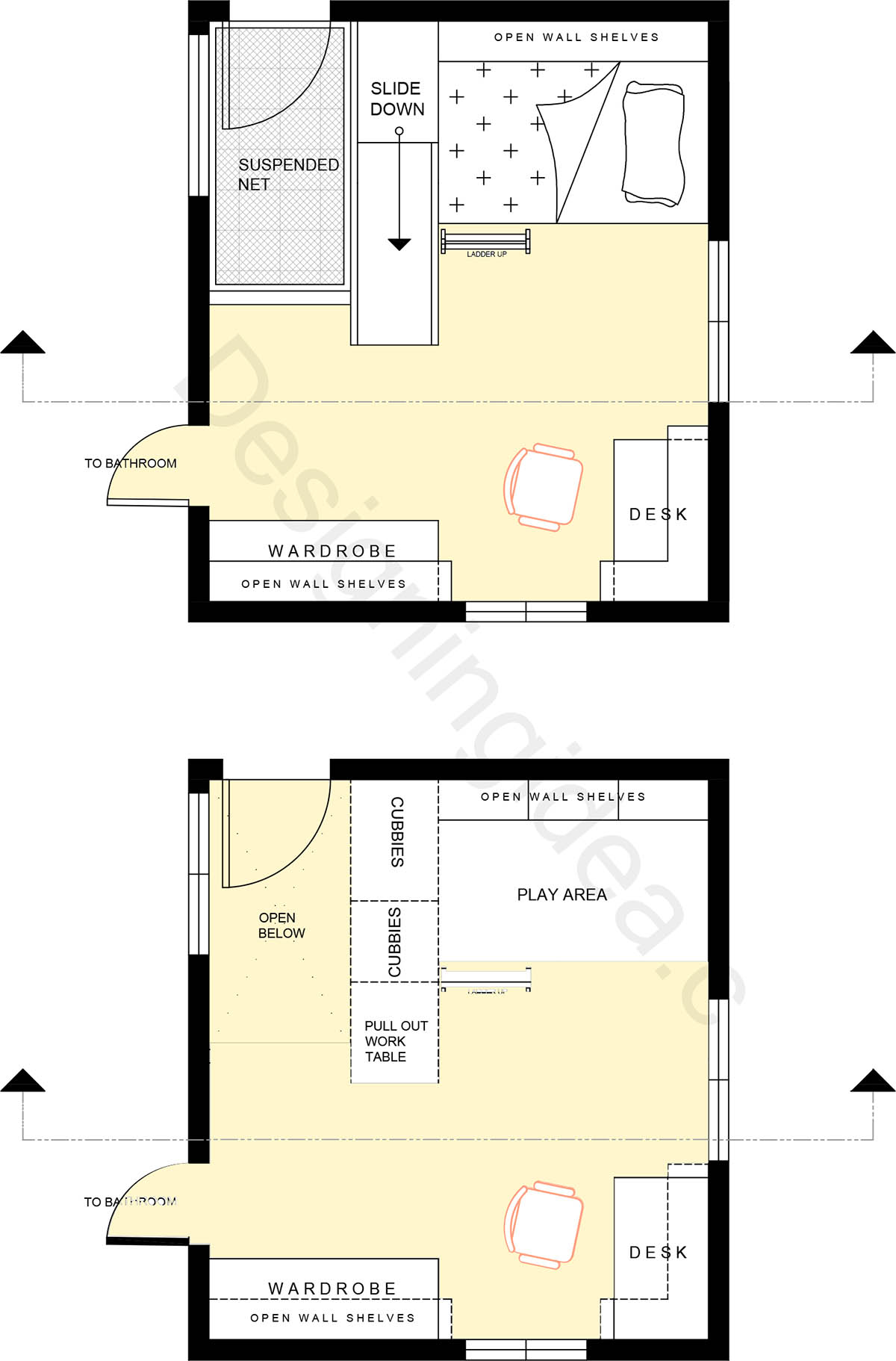
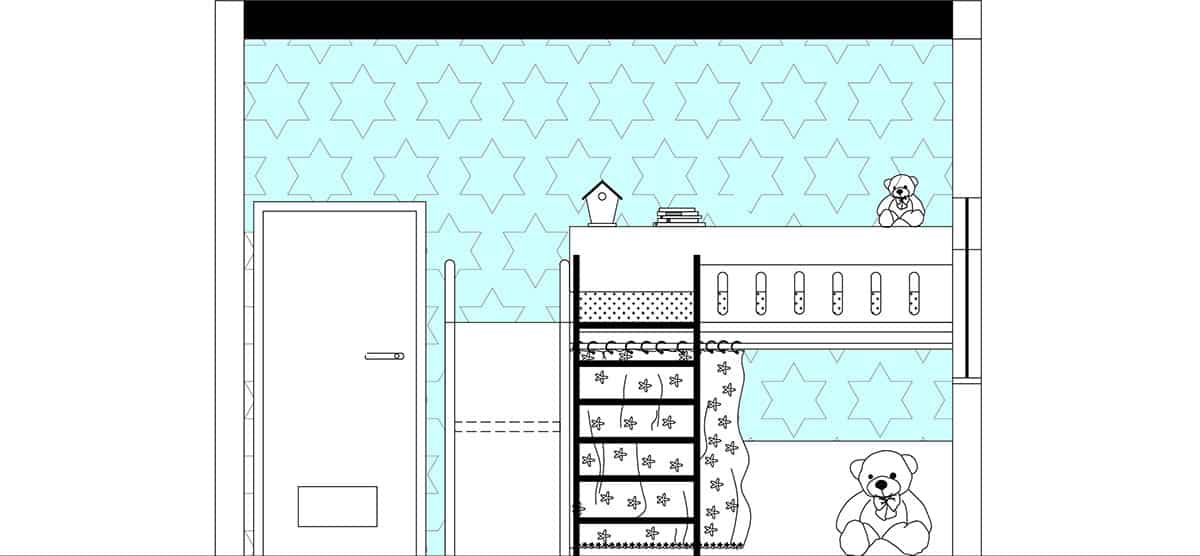
Curtains are added to give it a whimsical and princess-like theme. Narrow cubbies can be placed on one side of your bed loft frame to hold toys or books. A dedicated wardrobe is provided, and the desk is located away but accessible from the bed area. A provision for a second bed is possible, or it can be integrated with your wardrobe cabinet as a folding Murphy bed.
Underneath the slide are additional storage spaces, and a pull-out worktable can be accessed from the end to serve as a crafting or painting area.
Murphy Bed for Sleepovers
Use a wall-mounted Murphy bed that can be folded up during the day, leaving plenty of floor space for playing. It can be used as a regular bed or an extra bed for sleepovers.
Layout: This children’s bedroom has an ample play area, but adding an additional bed for sleepovers doesn’t require blocking your play space and traffic aisles. Instead, a Murphy bed is fastened at the sides along your built-in cabinet and shelves. The study area is placed against a corner, and a dedicated wardrobe area is positioned along the bed just beside the bathroom door. This layout makes it easier to expand in the future.
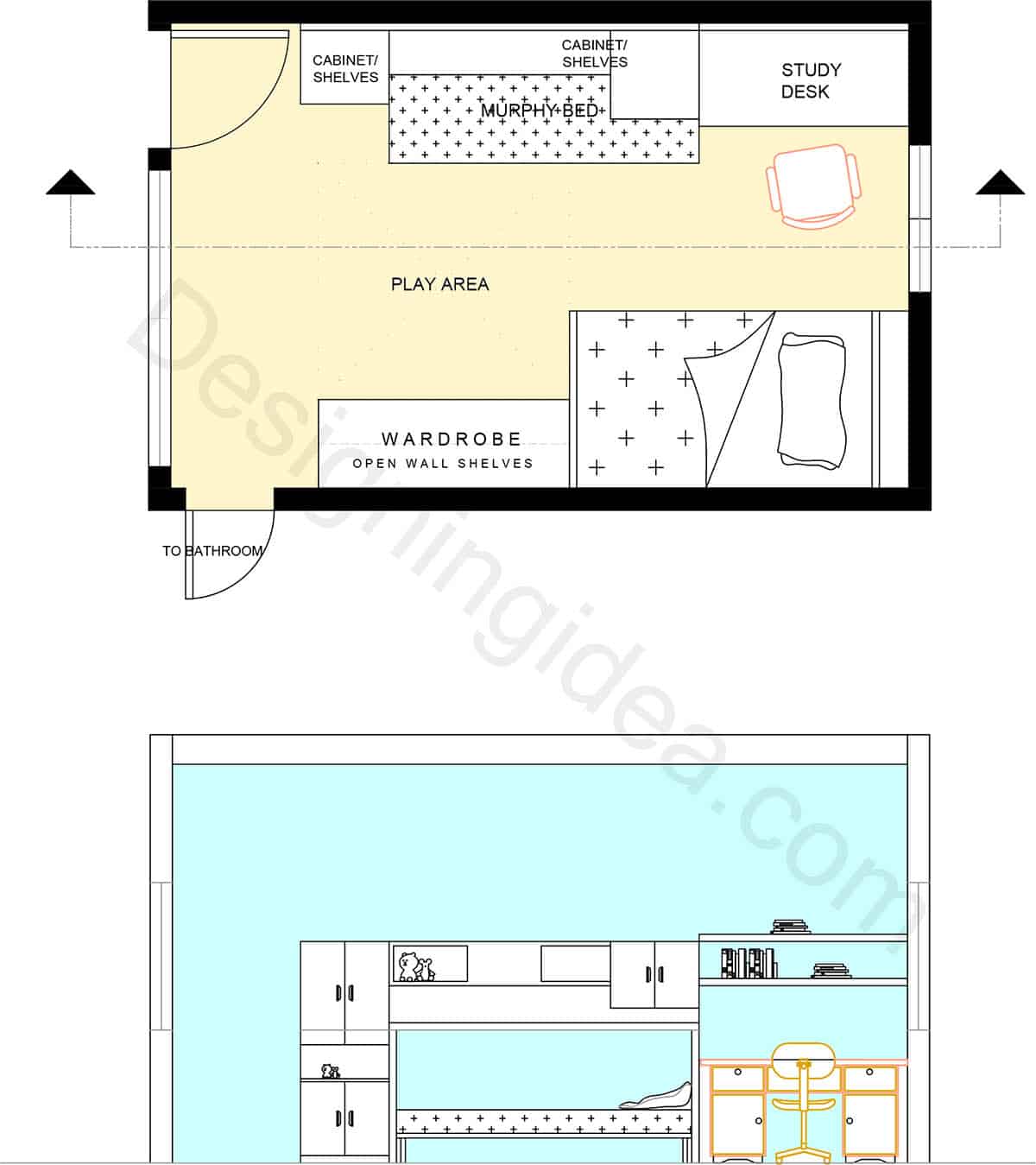
What is a Murphy bed?
Named after the president of Murphy Bed and Door Company, the Murphy bed has become synonymous with any pull-down bed or fold-down bed that is hinged at one end of a wall. Typically flanked by closets and cabinets.
Built-in Bed With Shelving
Opt for a built-in bed with shelving units along the side or above the headboard. This design provides extra storage for books, toys, and decor, reducing the need for additional furniture.
Layout:
A built-in bed with shelving saves more space since you can customize the placement, size, materials, features, etc. The layout works around the two large window panels by fixing the furniture and bed against a corner with no fenestration. This leaves the flow of natural light and ventilation uninterrupted. Because the bed is surrounded by a lot of cabinets or shelves, it can look busy and overcrowded.
Options:
- Headboard shelving: This is the type of built-in bed with shelving shown in the layout. This type of bed features shelving attached to the headboard, providing easy access to books or other items.
- Underbed Shelving: Some built-in beds have shelves underneath the bed, offering additional storage space without taking up floor space.
- Built-In Closets: For larger rooms, built-in beds can be combined with a closet, providing a complete storage solution.
Trundle Bed with Extra Storage
Use a trundle bed that rolls out from underneath the main bed. This is ideal for sleepovers and saves space by tucking away when not in use. Look for options with drawers beneath for added storage.
Layout:
A perfect alternative children’s bedroom solution for rooms where bunk beds or loft beds are not possible due to the low ceiling height. The layout adapts to the shape of the floor plan, which has the bed against one wall, freeing enough space for a trundle bed. Even if the toddler bed is in use, there’s ample space for traffic. The squarish plan and 45-degree angles give an opportunity for a 180-degree study desk and a lounging area with a provision for a walk-in closet in the future. The layout maximizes the natural light coming through the room.
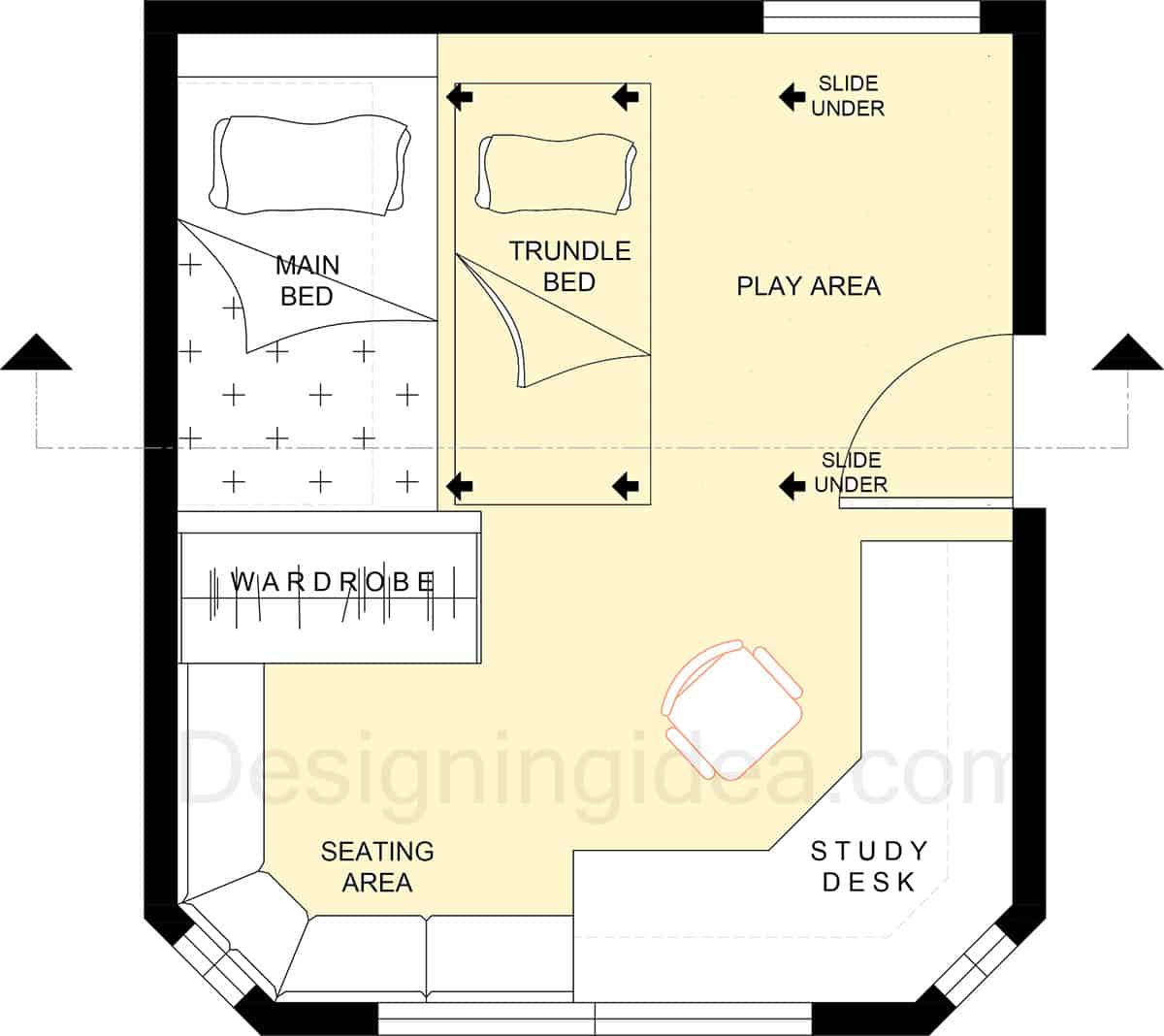
Types of Trundle Bed:
- Basic/Classic Trundle Bed: The most basic type, featuring a single bed that rolls out from underneath the main bed. It is ideal for children and as a guest bed.
- Storage Trundle Bed: Basically, has a similar build as the classic c trundle bed but with storage compartments underneath that are perfect for kids’ toys, clothes, or linens. This further maximizes the space.
- Twin-Over-Trundle Bed: Stackable design: Features a twin-size bed on top and a trundle bed underneath. This is perfect for small spaces and ideal for children’s rooms or shared bedrooms.
- Custom Trundle Beds: These can be designed with specific dimensions, materials, or features where it ensures a perfect fit for special requirements.
Convertible Bed with Desk
Choose a bed that converts into a desk or table when not in use. This dual-purpose furniture saves space, allowing kids to have a study area and a bed within the same footprint.
Layout: For a small children’s bedroom, a Murphy bed with a desk underneath can save much space, and both can be neatly tucked against a wall when there’s a need to free up the room space. This layout places the bed and desk at the center of the room to create symmetry within the small space. This gives access to the furniture, such as the shelves and wardrobe.
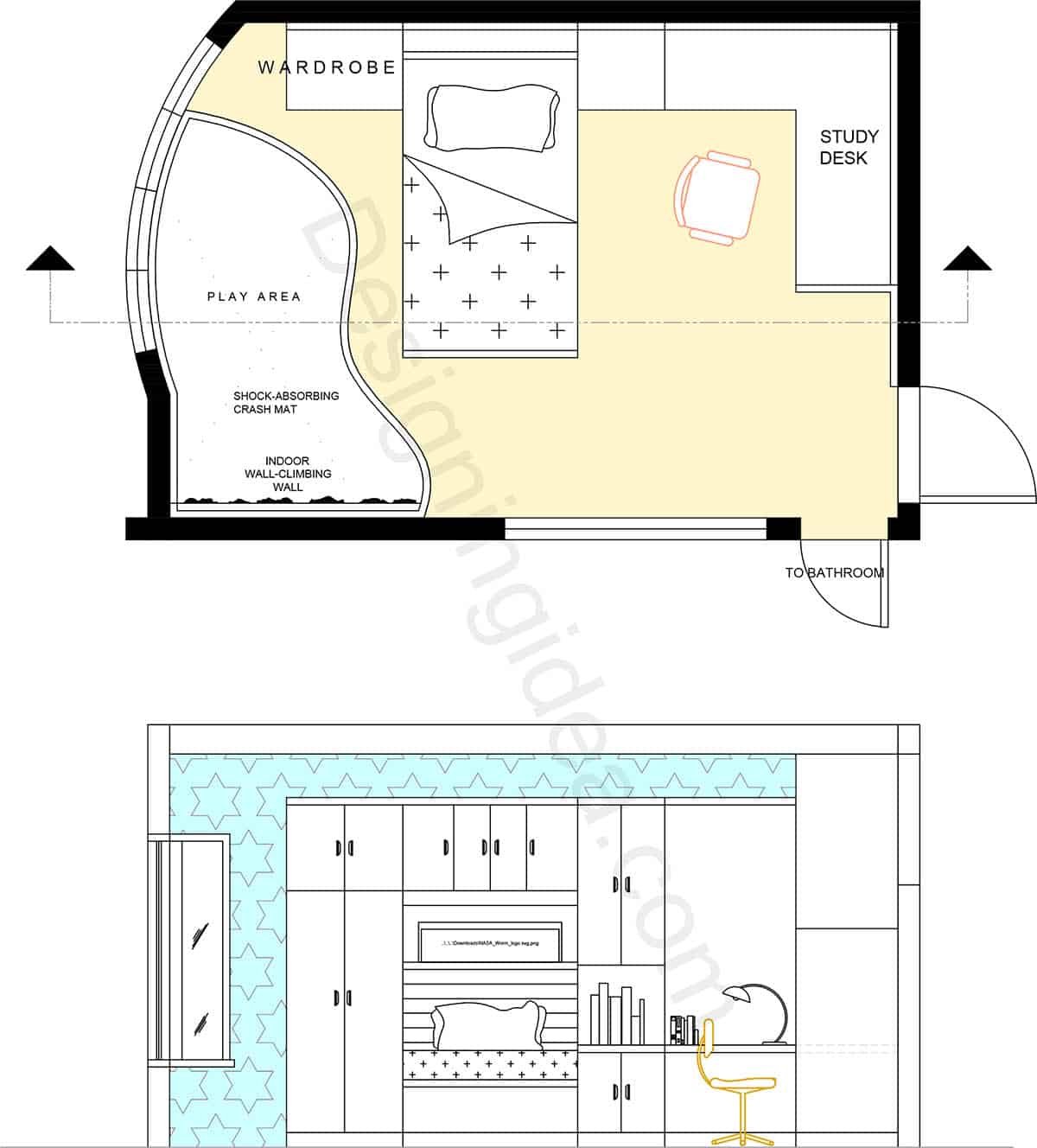
Types of Convertible Beds with Desks:
- Murphy Bed with Desk: This type of bed features a built-in desk that folds down when the bed is lowered. When the bed is raised, the desk can be used as a workspace.
- Trundle Bed with Desk: A trundle bed with a built-in desk as shown previously can be a great option for small bedrooms. The desk can be used when the trundle bed is not in use, and the bed can be pulled out and used as a separate sleeping space.
- Daybed with Desk: A daybed with a built-in desk is a versatile piece of furniture that can be used as both a bed and a sofa. The desk can be used for working or studying, and the bed can be used for sleeping or lounging.
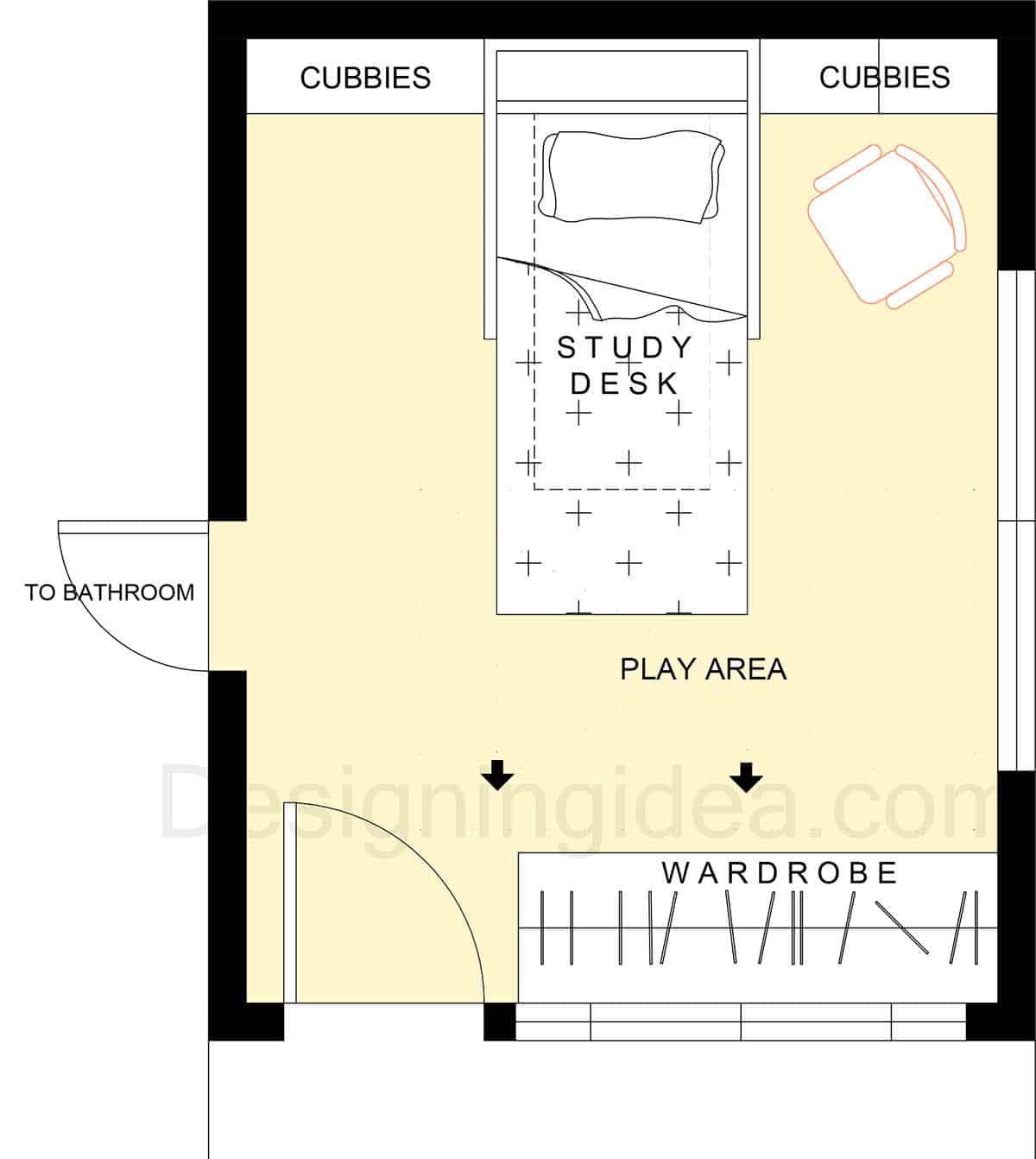
- Loft Bed with Desk: A loft bed with a built-in desk is a great way to maximize space in a small bedroom. The desk can be placed underneath the bed, and the loft bed can be used for sleeping.
Corner Beds With Shared Storage
Arrange two twin beds in an L-shape in a corner, sharing a storage unit between them. You can use the shared space for a bookshelf, a dresser, or a toy chest, maximizing corner areas that are often underutilized.
Layout: Positioning the beds in an L-shaped form that fills in one corner of the room utilizes the corner area while freeing up the center to create a large play area for two occupants. The study desks are available under each bed, which gives them privacy when studying. A curtain or a sliding door or wall can be incorporated along the lower level to increase privacy for the children.
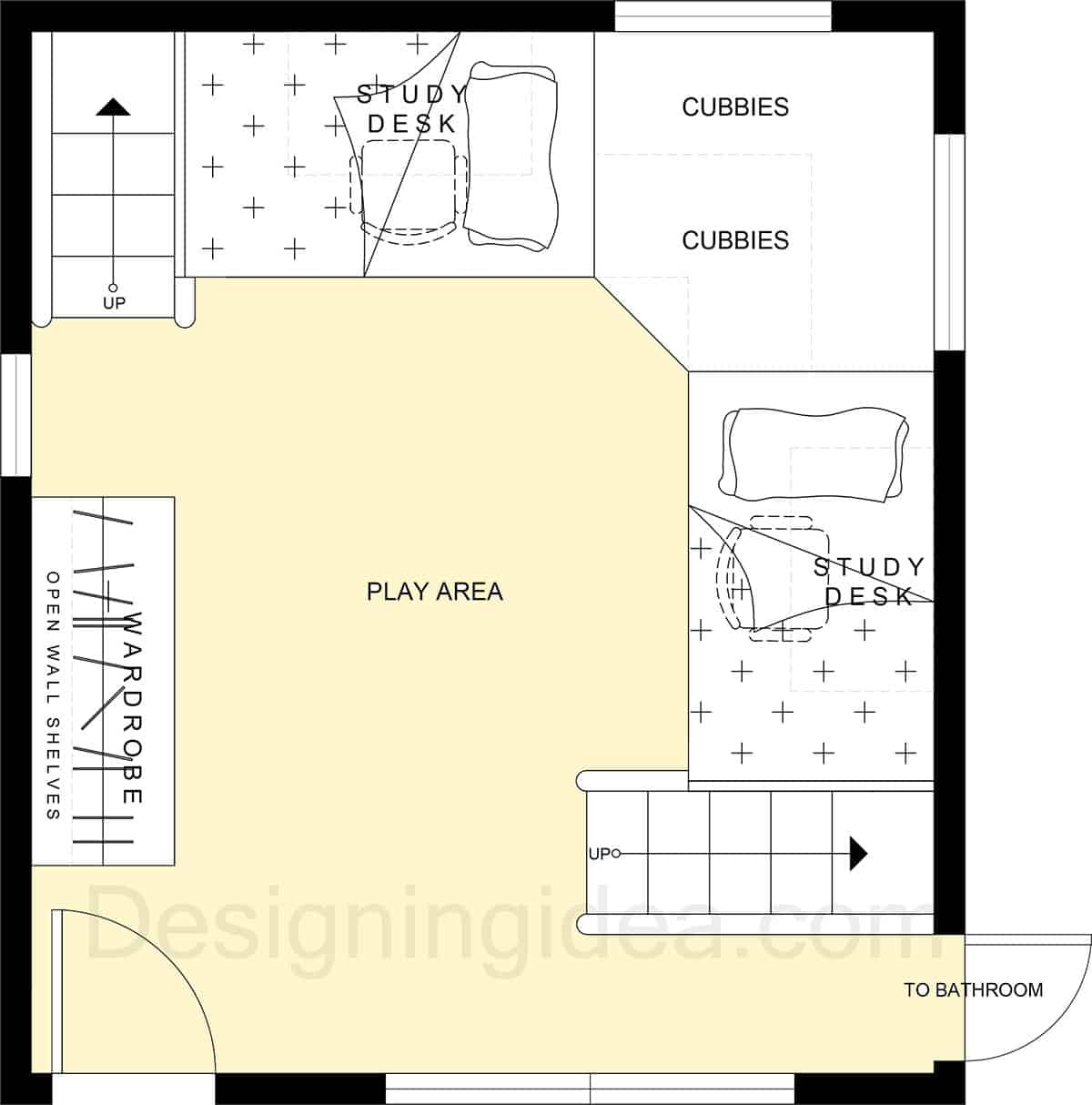
Platform Bed with Steps and Storage
Install a platform bed raised slightly off the floor, with steps leading up to it. The steps can double as drawers, providing storage while also making the bed easier for younger kids to access.
Layout: According to top mattress manufacturers, a platform bed will typically have a height of 6 inches to 18 inches off the ground. The free space underneath a platform bed is perfect for integrating pull-out drawers for clothes and other smaller items. This keeps the space neat and leaves a minimalist look. Usually, a low flight of stairs is integrated within the platform, especially for higher beds. These steps also have smaller drawers’ underneath, or the riser covers are revealed and made to store items such as books or toys.
With limited square footage, the layout leaves an aisle along the entry point and utilizes a corner for the platform bed. This also gives enough space for a play area and large slide-out drawers to be fully drawn under the bed platform. A study desk and wardrobe are set against the opposite side.

Built-in Wall Bed With Cubbies
Incorporate a bed that folds into the wall with surrounding cubbies or shelves. These cubbies can store toys, clothes, and books, keeping everything in one compact space.
Layout: For kids’ bedrooms, having multiple storage units with smaller divisions for storing toys keeps the room organized. This also encourages young children to segregate items and keep everything organized. In this layout, the folding bed with built-in cubbies is placed at the center of the longest side of the room to accommodate the total length of the built-in. This layout leaves ample depth for a study desk that protrudes along a corner of the room. On the opposite side is the bathroom near your wardrobe area.
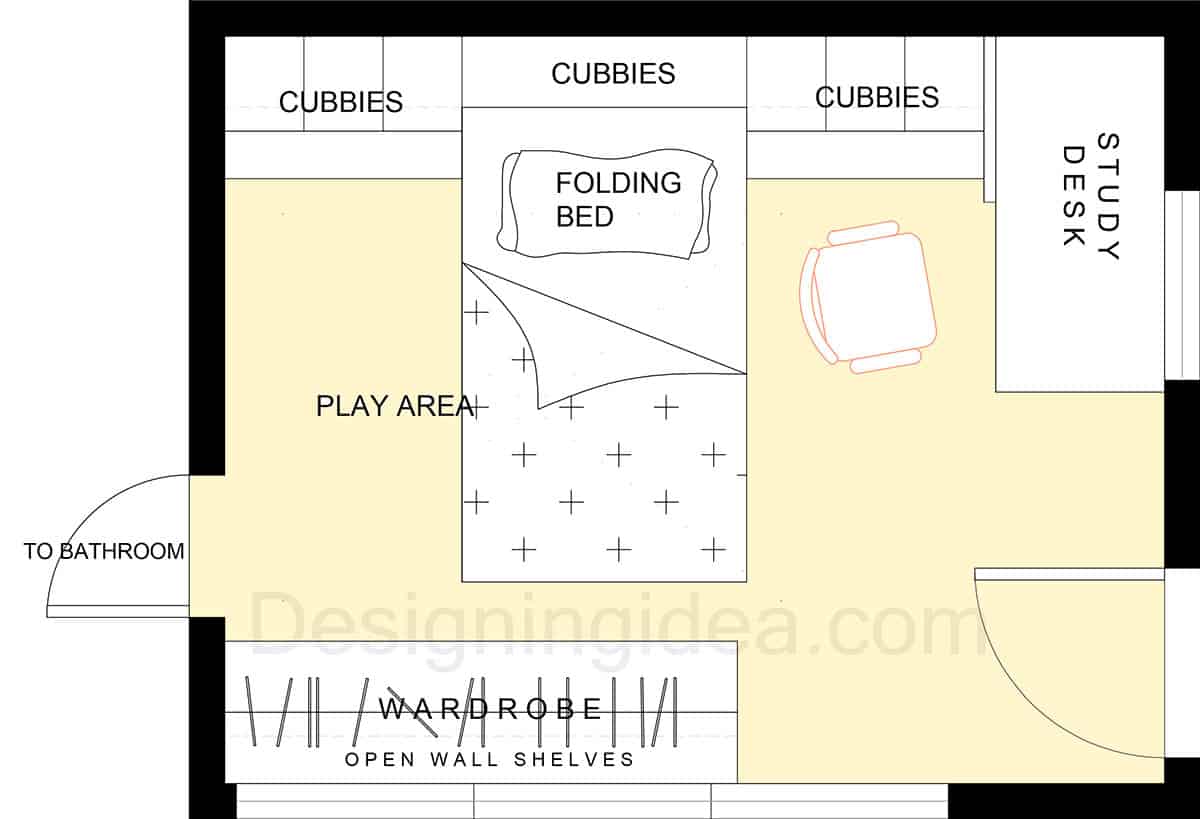
Double-Deck Storage Bed
Consider a double-deck storage bed with the bed raised high and pull-out storage units’ underneath. These units can hold clothes, toys, or art supplies, effectively using the floor space under the bed.
Layout: Despite the large space, the layout opted for a double-deck storage bed, freeing up a spacious play area that can be easily converted into another room or bed space in the future. Storage for toys and books as well as the sleeping area is positioned on one side of the room. The wardrobe at the end can expand further into a walk-in closet next to the bathroom in the future.

For more designs like this, check out our playroom floor plan ideas page.

